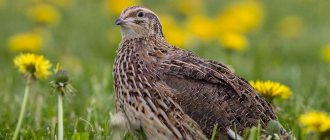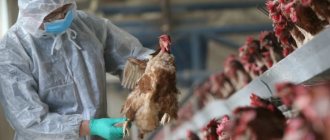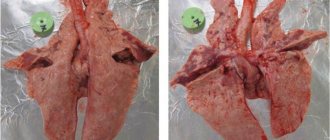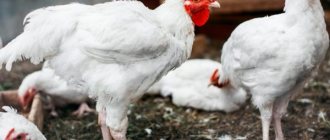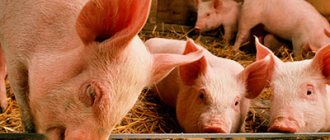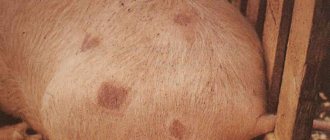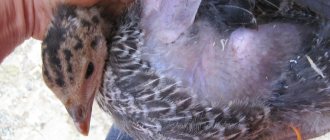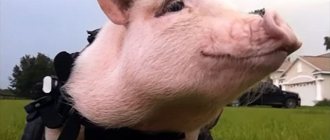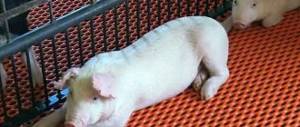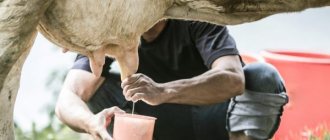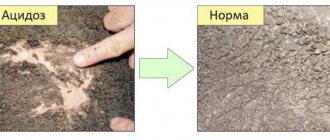How to prune correctly
How to properly trim a chicken's wings? The process is not easy and requires certain skills. There are no strict rules for caring for a bird during the procedure, but in order not to injure the individual, you need to know exactly how to trim the wings correctly. If a poultry farmer is new to this business, it is better to seek help from more experienced farmers.
Required Tools
Each poultry farmer has certain methods for trimming the wings of his hens and cockerels. The most common tools:
Some use a hatchet. The main thing is that the tool is sharpened. The procedure will take little time and the bird will experience minimal stress.
Step-by-step instruction
Before trimming, you need to prepare the tool. We need to think about how to separate birds that have undergone the procedure from those who are about to undergo it.
Algorithm for the procedure:
Catching a bird. Chickens are nimble and timid. Therefore, before starting manipulations, it is better to drive them behind the fence. Holding the bird as close to you as possible, you need to straighten the trimmed wing. Pruning is done quickly and accurately
It is important not to harm the bird. To avoid affecting blood vessels and sensitive areas, the flight feathers are trimmed no more than 6 centimeters from the edge. The second wing is trimmed according to the same pattern.
How to trim a chicken's beak
Today, the most popular beak trimming method is using hot blades. It can be used both in small farms and in large poultry farms. Most birds in Europe and Russia undergo the procedure using hot blades. Certified equipment for this procedure is designed to cause as little pain as possible to the bird and ensure its well-being after the manipulation. To simplify the operator’s work, the procedure can additionally be controlled using a computer program.
With hot trimming, everything is more or less clear - with the help of heated blades, the bird’s beak is cut off from the sharp end. But there are also other, less popular technologies.
Infrared Beak Trimming
It is used in incubators on birds one day old. The surface of the chicken's beak is treated with high-intensity infrared light to prevent the development of diseases. After this procedure, the chicken's beak looks exactly the same as before, but after a few weeks the pointed tip falls off on its own.
In addition, in recent years, experiments have been carried out on laser beak trimming of birds, but due to the high cost, such technology cannot yet be used on farms.
Methods for solving the problem
Having discovered that laying hens attack weak individuals and peck them until they bleed or die, you need to take safety measures. Methods for solving the problem are varied. They include changing the conditions of keeping birds, adjusting nutrition, isolating weak chickens, and using special means to treat the wounds of affected individuals.
Diet changes
Since cannibalism is most often caused by a lack of vitamins and microelements in the body of birds, it is necessary to diversify their diet. Additives added to the feed:
- meat and bone meal – 10% of the total food volume;
- methionine – 1 g/1 kg of feed;
- sulfur – 1 g per head;
- table salt - no more than 1% of the total food volume;
- potassium – 2 mg per bird;
- shell rock
Solution
If the farmer, after observing, has established the reason why the chickens are pecking each other, he must take measures to eliminate it and cure the bird. You need to act wisely, adhering to the basic rules of keeping chickens. The first step is to temporarily remove the wounded chicken from the main flock, separating it with a wall or grille. Then proceed to the following measures to help eliminate pterophagia.
Elimination of imbalances in nutrition, introduction of additional protein into grain mashes (meat and bone meal, curdled milk, whey, fish and meat waste, broths). Not only animal, but also vegetable protein is suitable: it is very useful to give the bird legumes (peas, vetch), meal and cake. The main thing is to do this slowly, introducing protein gradually. Feeders with crushed chalk, shell rock, and adding eggshells to food will help replenish calcium.
For normal plumage change, it is important for chickens to receive microelements such as manganese, zinc, bromine, ferrous sulfate, sulfur, and selenium. From time to time, and especially during the molting period, it is necessary to add premixes and vitamin and mineral supplements to the chickens’ food.
Eliminate crowding. No more than 3-4 heads of meat birds or 4-5 hens are placed per 1 square meter of poultry house.
Providing the required number of feeders and drinkers, and a sufficient number of nests for hens. In the warm season, let the chickens out more often, hang green brooms (from nettles, clover), and give raw vegetables for additional vitamins.
Ridding birds of parasites is facilitated by installing a container with ash or sulfur in the poultry house, as well as disinfecting the premises with special means and temporarily removing the chickens from it.
In mild frosts in winter, chickens should be allowed to roam, at least for a short time.
Young flocks should be kept separate from mature chickens. The same rule must be followed with birds of different breeds.
Adjust the humidity in the room. If the air is dry, you need to place containers with water, but there is no need to allow dampness either.
It is important that the room has good ventilation, but there are no drafts, which chickens tolerate worse than cold.
Establish a daily light regime of 12-14 hours. Artificial lighting is installed at the rate of 60 watts per 10 square meters of poultry house; lamps should not be located close to chicken heads
It is also advisable to paint them blue or red. Artificial light should not burn for more than 10-11 hours a day.
Raising chickens is not an easy task and sometimes even small nuances affect the behavior of chickens. The pecking of chickens and roosters is direct proof of this.
Let's start with the fact that the chicken community living in the same chicken coop has a strict hierarchy. There is a main hen (maybe two or three) and the lowest individual - it is she who, over time, may face the fate of being pecked. By the way, the rooster may also turn out to be an outsider, pecked by formidable cohabitants.
Now we’ll take a step-by-step look at why chickens peck each other until they bleed and what to do about it, starting with the most common reasons.
The same goes for the comb, earrings, cloaca after laying an egg, drops of blood - the red color attracts attention and begs to be pecked into it
Eating disorders
Minerals and vitamins must be present in the bird’s diet. Their lack disrupts the entire body from the desired rhythm. This causes the nose and claws to grow quickly. Fatty foods affect not only their length. The liver and metabolic processes suffer.
In order not to encounter this problem, it is necessary to balance the parrot’s diet and create the necessary living conditions.
The growth of the beak is also affected by injuries, as a result of which the pet develops an incorrect bite.
Malnutrition as a consequence leads to accelerated beak growth
In adults, due to hormonal imbalance, rapid growth of the nose is also observed.
Why do you need to trim your parrot's claws?
Poultry often experience discomfort from excessively long nails. Often this condition is the result of incorrectly selected equipment for the pet - a perch of the wrong size, lack of edging made of natural fibers. In order for the claws to shorten naturally, the cage must be equipped with wooden perches. Their thickness should be such that the bird cannot completely wrap its paw around it - then the claws will begin to touch the rough layer of the perch, gradually grinding off against it.
Nevertheless, a haircut is necessary, since such a trim may not be sufficient. The manipulation must be performed for the following reasons:
- The parrot has discomfort when walking on flat surfaces.
- Unnatural distribution of pressure due to incorrect positioning of the paws - the toes are raised up, this provokes pain in the bird.
- Excessively long claws prevent the parrot from sitting comfortably on the perch.
- A pet sitting on the arm or shoulder will scratch the skin of the person holding it, which is quite unpleasant.
- While scratching, a bird can accidentally injure itself with a sharp claw.
- The pet will strive to solve the problem on its own - this often causes various injuries to the bird.
- If the claw is too long, it can split and break, causing bleeding - the parrot will feel severe pain.
It is better to trim the parrot's claws at home, otherwise there is a high probability of serious injury to the bird's paw. This happens because the bird clings to a cage, tulle or something else, but cannot let go of the object and continues to move. The result of this situation can be a dislocation, and in some cases, a fracture of the pet’s paw. In the best case scenario, the bird will tear out its claw.
Methods and rules for pruning
Debugging is not carried out on weakened and sick birds; they are separated from the main stock. The beak of such mulards can be trimmed only after full restoration of health and strength.
5-7 days before surgery, birds are given anti-stress vitamins. The bird is held firmly by the neck, 2-3 millimeters of the upper part of the beak are cut off with sharp scissors; after trimming, the wound must be cauterized with a pharmaceutical solution of iodine. The procedure is mandatory for the entire flock; even one bird with an untrimmed beak that ends up in a treated flock can cripple the entire flock.
After the procedure, the birds are offered enhanced nutrition; no additives are used that change the taste of the food. Provide livestock with clean drinking water. To prevent birds from going hungry, increase the number of feeders. Pruning promotes weight gain, significantly reduces mortality, the nest becomes quieter, and the birds do not start fights.
The procedure is unpleasant for the birds, but necessary; without it, feed costs increase with weight loss, the entire flock suffers from cannibalism, and can die from pecking or from infection in the wound.
Other techniques for holding a bird
In order to prevent the flight of young animals, it is recommended to stretch the mesh around the walking yard or enclosure to a height of 2 m. It is also practiced to cover the enclosure with a mesh roof.
According to farmers, shiny Christmas tree tinsel hanging on top of the net also prevents birds from flying out. In this case, the effect of surprise is triggered - in nature there is nothing similar to Christmas tree rain, and the turkey simply does not have an experience-based way of interacting with it, so it does not risk flying through the tinsel.
The wings can be fixed with special wing clamps (see class patents A01K37 “Device for fixing birds”), which limit movements. It is also practiced to tangle the wings using tape.
Tangling wings using tape
To secure the wings using tape, select a tape made of soft material 1–2 cm wide. One end of the tape is fixed to the first joint of one wing, passed under the turkey’s belly and secured to the first joint of the second wing.
Cauterization of wings of day-old turkey poults
To cauterize, take a thin plate of iron, heat it over a fire, and apply it to the last joint of the wing. This operation can be performed only on day-old chicks. The wounds of turkey poults heal quickly, and in the future the birds do not fly.
It is believed that well-fed turkeys and crosses also do not fly. These birds are hampered by their weight. Each farmer can choose from a variety of methods for attaching wings any one to which he is more predisposed. You just need to remember that the chosen method should not cause inconvenience to the birds.
With this question in “Boss” N17 (p. 7), we asked readers to tell us about methods of influencing birds so that they do not fly. By this time two pieces of advice had arrived.
One of them is from Flaviy Ivanovich Yuganov from the city of Zheltye Vody, Dnepropetrovsk region. It seems to me that this advice is more theoretical and has not been tested in practice. And yet there is a rational grain in it, and therefore it can be tried (Ed.). The essence of this advice is as follows. Of course, it is impossible to stop a bird from flying, but is it possible to deprive it of its freedom to move through the air? It is possible without resorting to extreme measures (pulling out feathers or amputating wings). First of all, this begs the following question: is the environment comfortable for turkeys in their backyard? That is: 1. What are the sanitary conditions? 2. Is there enough food and water? 3. Do other animals offend or frighten them? 4. Are there parasites on the skin? 5. How many males? Preferably two. Let's assume that the answers to these questions are quite positive, but turkeys. fly. You need to take a strip of durable material (tape 1-1.5 cm wide). Tie one end loosely through the feathers around the first joint of one wing and, passing the tape under the bird’s belly (behind the legs), tie without tension to the same joint of the other wing. This measure will deprive the bird of the opportunity to spread its wings and flap them.
F.I.YUGANOV, st. Mayakovskogo, 125, apt. 20, Zheltye Vody, Dnepropetrovsk region, 52209.
The second advice was sent by an experienced veterinarian V.V. Toglieva from Poltava region. This technique is more realistic, although its implementation requires a certain skill and psychological attitude: do not torture tiny one-day-old turkeys and ducklings by burning certain tissues on their wings.
Burn the wings of the daily
Take a thin elastic plate of iron, heat it over a fire and attach it to the wing of a day-old turkey (to the last segment - along the joint). The tissues will burn out, the wound will quickly heal, and the problem will disappear. Females who will incubate chicks do not need to undergo such an operation. I do the same with muscovy ducklings and day-old chicks. Once they brought musk ducks from me to Grebenka (a city in the Poltava region - Ed.). A year later I met this hostess. She asked why people's musk ducks fly, but hers sit at home. I had to declassify this issue. After cauterization, the wound heals quickly, and if you cut it off with scissors, it bleeds. The operation should only be performed on a daily basis. In older people, bleeding is frequent.
V.V. TOGLIEVA, p. Dubrovka, Mirgorod district, Poltava region, 37622.
Chickens, geese, turkeys and other poultry love to fly up onto perches and fences in their enclosures. They are able to fly over the fence, and later the farmer may miss them.
There are several ways to solve the problem: fence the house from above, install a high fence or trim the feathers regularly. It is necessary to trim the wings of chickens correctly to prevent them from flying.
Internal organs
The anatomy of the internal organs of poultry is also somewhat different from the structure of the internal organs of more familiar mammals. Read more about them below.
Digestive system
It begins with a beak, has such an interesting intermediate link as a crop, and ends with a cloaca. The beak is intended exclusively for swallowing food; nature did not endow birds with teeth, since they would significantly weigh down the bird’s head. It is precisely because primary fermentation of feed does not occur in the oral cavity of chickens that they need a crop. There, food accumulates, which gradually moves towards the muscular organ - the stomach, which has glandular and muscular sections.
The movement of food is carried out through the esophagus; it is a long muscular tube, the main function of which is transportation, because no enzymes or juices are secreted there. Fermentation begins directly in the glandular stomach, where strong acid and enzymes necessary for digestion are abundantly released. In addition, pebbles and sand can often be found in the bird's stomach. Birds purposefully swallow such foreign objects. They become part of the bird's digestive system and help it grind roughage.
Digestive system: 1 - oral cavity, 2 - esophagus, 3 - goiter, 4 - glandular stomach, 5 - muscular stomach, 6 - duodenum, 7 - pancreas, 8 - gallbladder, 9 - liver, 10 - intestine small, 11 - ileum, 12 - cecum, 13 - rectum, 14 - cloaca.
The food then moves into the duodenum and small intestine. There, useful substances and vitamins will be “taken” from it. Undigested food will form into feces in the large intestine, which ends in the cloaca. I must say that this is the only “way out” of the chicken body. The entire digestion process in birds occurs very quickly; coarse grains take the longest to digest.
Respiratory system
The unusual structure of the respiratory organs is due to the fact that birds need a very large amount of oxygen during flight. And, although the birds in our backyard have practically lost interest in the sky, the structure of their respiratory system is atypical. The start of the respiratory system is the nostrils, then the air goes into the nasal cavity and larynx, then comes the trachea, which divides the air into two bronchi.
At the branching point of the trachea there is the so-called lower larynx, which serves as an organ of sound production. The bronchi extend beyond the lungs and communicate with multiple air sacs located in the bird's body. Air sacs are now only found in birds; dinosaurs supposedly had them, so birds are often credited with being related to extinct reptiles. Most of the air inhaled by the bird “settles” in the air sacs, approximately 75%.
Chicken lungs practically do not change their volume; they are not able to stretch as much as the lungs of mammals do. At the same time, the respiratory system of birds is not equipped with any valves; all air movements in it are subject to the laws of thermodynamics. In addition, air sacs serve for thermoregulation and gas exchange.
Circulatory system
The circulatory system of domestic birds is represented by a four-chambered heart, pulmonary and systemic circulation. Moreover, both circles of blood circulation are separated and venous blood never mixes with arterial blood. Venous blood, collecting in the right atrium, passes into the right ventricle. Then, moving along the pulmonary artery, it enters the lung and, saturated with oxygen, returns to the left atrium. This is what the pulmonary circulation looks like.
The systemic circulation begins with the left ventricle, from where blood from the aorta flows to all organs and systems of the bird through many small blood vessels. It must be said that the chicken’s heart is quite large compared to the size of the bird and looks asymmetrical. Its left side has a larger volume and does more “work”. In addition, all birds have high blood pressure and a rapid pulse.
This is due to the bird’s high body temperature and its rapid metabolism, which requires blood to circulate through the vessels at a high speed. And then in the video you can admire the walking poultry.
Extraction system
The excretory system of a chicken is represented by paired kidneys, which communicate with the cloaca through the ureters.
An important anatomical feature: chickens do not have a bladder, and the absorption of water from urine occurs directly in the cloaca.
Due to the absence of a bladder, chicken urine has an atypical appearance. It is thick and mushy and is not always distinguishable from feces. Moreover, the amount of feces in chickens is much greater than in mammals. This ensures the lightness of the body that birds need in flight.
Reproductive system
Chickens also reproduce differently from us; our feathered friends are oviparous. In males, the reproductive organs are the testes, located next to the kidneys. The testes greatly increase in volume during bird breeding. The spermatic ducts extend from the testis, which end in the seminal vesicle - the receptacle for sperm. Chickens do not have an external genitalia; fertilization is carried out by contact of the cloaca of the rooster and the hen.
In the female, only one ovary is properly developed - the left one. It is also located near the kidney. The left oviduct departs from it, which opens with an expanded funnel into a convoluted thick-walled tube communicating with the cloaca. The oviduct is divided into several sections: the upper one is called the fallopian tube, followed by a wide section called the uterus. From the moment the egg enters the oviduct until the hen lays the finished egg, 12 to 48 hours pass.
Nervous system
The nervous system of chickens is represented by the brain and spinal cord, as well as nerve processes and fibers, through which nerve impulses are transmitted throughout the bird’s body. The brain consists of the forebrain, diencephalon, midbrain and cerebellum. The cerebral hemispheres are small and lack convolutions. This is probably why they often talk about “chicken brains” as something insignificant.
The hemispheres of the brain carry out orientation in space and the implementation of chicken instincts. The cerebellum is responsible for the coordination of movements.
How does debriding work?
Today, the most popular beak trimming method is using hot blades. It can be used both in small farms and in large poultry farms. Most birds in Europe and Russia undergo the procedure using hot blades. Certified equipment for this procedure is designed to cause as little pain as possible to the bird and ensure its well-being after the manipulation. To simplify the operator’s work, the procedure can additionally be controlled using a computer program.
With hot trimming, everything is more or less clear - with the help of heated blades, the bird’s beak is cut off from the sharp end. But there are also other, less popular technologies.
It is used in incubators on birds one day old. The surface of the chicken's beak is treated with high-intensity infrared light to prevent the development of diseases. After this procedure, the chicken's beak looks exactly the same as before, but after a few weeks the pointed tip falls off on its own.
In addition, in recent years, experiments have been carried out on laser beak trimming of birds, but due to the high cost, such technology cannot yet be used on farms.
Required Tools
Industrial poultry farms have devices for beak trimming that have high productivity. At home, dewetting is done with scissors, garden pruners, and experienced farmers use a soldering iron for this. If you lack the skill, especially if the owner is going to carry out the procedure for the first time, it is better to seek the help of a more experienced assistant or call a veterinarian. To treat the wound after pruning, an iodine solution is needed.
See also
Do ducks and ducklings need to leave drinking bowls with water at night and their placementRead
Should chickens' wings be clipped: advantages and disadvantages of the procedure
The flying abilities of chickens are limited to a height of 1.5-2.5 m, but this is enough to fly over the fence that limits the place where the birds are kept. Breeders argue among themselves about the advantages and disadvantages of clipping the wings of chickens, since in addition to the described advantages, this procedure also has a number of negative effects. The advantages of performing the procedure include:
- the owner’s peace of mind regarding the integrity of the crops;
- eliminating the possibility of birds getting onto a neighbor's property or onto the roadway;
- reducing the risk of losing some individuals, which otherwise arises when they meet pets on someone else’s property.
As we can see, the advantages of performing this operation lie mostly in the area of convenience for the breeder, but do they contradict the physiological characteristics of the bird’s life cycle? Unfortunately, the answer from experts to this question is partially affirmative, since it is based on a number of negative effects associated with clipping the wings of chickens, including:
- Violation of the integrity of the natural plumage affects the ability to hatch eggs, since trimmed primary wings ensure their turning over and proper heating. Reducing the length of these wing elements reduces the area covered by the hen when incubating eggs and leads to insufficient heat necessary for fetal development.
- Despite the arguments of supporters of wing clipping, opponents of the operation emphasize that depriving the bird of the ability to fly to a height of about 2 m excludes the bird’s ability to reach its favorite perches and nest sites. This in turn represents a stressful situation for the hen, which is likely to affect the performance of the wing-clipped individual.
- A decrease in the length of the flight feathers, according to the observation of breeders, can affect the molting process in the affected area of the wings.
Despite the above disadvantages, the operation of clipping the wings of chickens is practiced by a significant number of breeders. Adherents of the opposite point of view should remember that by refusing to carry out the procedure, the farmer will be forced to either limit the flight capabilities of the bird, for example, by changing the conditions of its keeping, or build additional fencing, which is fraught with an increase in material costs and production costs.
Is it possible to trim the wings of a rooster?
Roosters rarely fly away - mostly they fly up only to climb higher and have access to inspect their territory. Unlike curious females, they are in no hurry to fly away from the site, so there is no urgent need for trimming the roosters’ wings.
Some farmers are of the opinion that such a procedure is generally undesirable, since wings are an important element in courtship. After pruning, males may abandon their duties as guardians of the coop and, even worse, from fertilizing females.
The main reasons for the aggressive behavior of a rooster. What to do if a feathered aggressor pecks and attacks a person?
Read
Will chickens lay eggs without a rooster, and is one needed in the herd? Advantages and disadvantages of keeping roosters and hens together
More details
Why do roosters crow morning, noon and evening? How to stop a rooster from crowing too loudly?
Look
A rooster systematically pecks a chicken until it bleeds - what is the reason for this behavior and how to stop it?
Further
How to prevent eggs from pecking?
No matter how wonderful the prospect of trimming the beaks of birds may seem to prevent them from fighting and pecking, this is not possible everywhere. In some European countries, debriding is officially prohibited, and in some other places they are planning to introduce such a ban.
The reason is changes in animal care procedures and increased demands on their welfare. Some poultry production schemes, such as the UK's Freedom Food Eggs, allow trimming but do not use hot blades. This method is considered not too humane and producers, following the latest trends, trim the beaks of their wards using non-contact methods.
But even before the official adoption of the famous “animal welfare directive,” scientists and technologists were actively looking for alternative ways to reduce pecking in chickens on poultry farms. Today they have the following methods in their arsenal:
Genetic selection of birds
The desire to peck and the ability to carry pecking to the maximum extent (feather plucking and cannibalism in birds with high mortality rates) varies depending on the breed of chicken. There are some that simply cannot be raised without beak trimming, and some do not require it at all. Modern molecular technologies make it possible to achieve changes in the genome of birds, reducing their aggressiveness, and this is an excellent alternative to surgical intervention.
Light regime in the poultry house
Chickens have color vision, so various changes in lighting conditions affect their behavior. Green and blue colors of the spectrum enhance growth and slow down puberty. While red, yellow and orange, on the contrary, enhance puberty. Red and orange colors also increase egg production.
Birds are much calmer in blue light. For many years it was customary to breed and raise chickens under red light, as this was considered the most favorable for protection against cannibalism. The birds simply did not see drops of blood on each other, which did not provoke pecking. Currently, the most successful technique for preventing cannibalism in chickens is to raise them in dim white light. Birds simply do not see each other in such lighting well enough for them to want to start fighting - such lighting for chickens is equivalent to night lighting. However, such cultivation can cause visual impairment, which is also not very consistent with the principles of welfare adopted in Europe.
Proper feeding of poultry
One of the effective ways to prevent feather plucking and egg pecking in chickens is the correct diet. If you provide birds with food that they will happily start pecking at, many troubles can be avoided. Crushed grain, empty milk cartons, vegetable tops hung on the walls of the cage are perfect for these purposes.
All this attracts the attention of the birds and provokes them to peck what they see in the cage, and not each other.
To minimize outbreaks of cannibalism in birds, it is necessary to add some indigestible fiber to the diet of laying hens. Wheat, oat and rice bran with grain shells are suitable for these purposes. Having to digest large amounts of fiber makes birds calmer. Of course, we should not forget about the balance of mineral nutrition.
Beak abrasives
Adding hard particles to the food will create an automatic beak trimming effect - it will simply wear off and become blunter at the end. This technology is used in the early stages of the life of chickens, when they are still at their most tender age. If such procedures are carried out in a timely manner, a pointed tip will not appear at the bird’s beak.
Chemicals for chickens
Enterprising inventors have come up with a number of drugs that discourage birds from tasting their cage mates. The substances are sprayed on the birds and actually reduce the number of bloody incidents. However, the drugs are not yet particularly popular.
Free range
Although people have been trying to defeat nature for many years, the solution to the problem of pecking in chickens lies on the surface. If you provide the birds with enough space to walk and bring their living conditions closer to natural ones, they will become much calmer and will not peck each other to death.
How to prevent pecking in chickens?
No matter how wonderful the prospect of trimming the beaks of birds may seem to prevent them from fighting and pecking, this is not possible everywhere. In some European countries, debriding is officially prohibited, and in some other places they are planning to introduce such a ban. The reason is changes in animal care procedures and increased demands on their welfare. Some poultry production schemes, such as the UK's Freedom Food Eggs, allow trimming but do not use hot blades. This method is considered not too humane and producers, following the latest trends, trim the beaks of their wards using non-contact methods.
How to trim a chicken's beak
Just like chicken claws and dog and cat claws, there is a blood supply inside the beak. As the beak becomes longer, it is safe to trim only the very tip
Be careful not to overdo it and damage living tissue and blood vessels.
- On the pale and light beak, the part that can be trimmed can be seen in the light.
- On a dark beak, the trimming portion looks much lighter.
How to trim a chicken's beak
Cat nail clippers are great for this. If you don’t have any, then take nail clippers.
- Hold the chicken tightly in your hand, holding the head with your thumb and forefinger.
- Hold the chicken's beak up to the light to determine the cut line.
- Bite off the tip and let the poor guy go.
You can also use a nail file to file down just the tip of the beak. You can handle chicken!
How to trim the beak of a chicken or rooster
An assistant is needed here. If no one agrees to help, then wrap the chicken or rooster in a sheet or large rag. Tight!
You can bite off with nail clippers. A cat nail clipper will not take the beak of an adult chicken. Use either a nail clipper for large dogs or an electrician's clipper!
If the beak is particularly long, it is best to trim it in stages. Trim just a little and wait a week before trimming again.
Free-range chickens do not have beak or claw problems. So add some naturally beautiful rocks to your chicken pen and coop. Or you can just use bricks. My girls have a couple cinder blocks in their chicken coop. No - these are foam blocks!
It is interesting to watch the laying hens scratching their beaks on the paving stones in the yard. At first it shocked me. But now I know why they do this and how to trim the beak of a chicken or rooster quickly and easily.
About chicken pedicure with spurs on roosters, see this link.
And let's not use debeaking at home. This is inhumane... I think that among my readers there are no poultry farmers who cut off the tip of a chicken's beak in childhood to prevent egg pecking, cannibalism and feather plucking. A balanced diet and good conditions are what saves you from such misfortunes.
As a last resort, a hooligan can be dressed up in chicken glasses for a week. For re-education.
Good luck!
Subscribe to site updates and our channel “Chicken” in Yandex.
See you later, colleagues! In the meantime, we will prepare new and interesting information for you!
See modern products for poultry and livestock farmers that improve the health of pets and make our work easier.
Feather trimming technology
Scheme for trimming chicken wings
A poultry farmer’s natural reaction to the flapping of a chicken will be pity, but here you need to show persistence and confidence. The bird will suffer more from uncoordinated actions. Trimming technology is based on the following steps:
- The birds selected for the procedure are driven into a separately prepared compartment. It should be small in size to make it easier to catch chickens. Maximum tightness is considered a good option. To calm and distract attention, feeders with grain are installed. When the chickens begin to peck, each individual is carefully caught by hand. If they are nimble, cover them with a cardboard box or a fishing net.
- The caught individual is held with his hands, pressed to himself, for about a minute. They try to calm her down by stroking her. If the individual is violent, the head is covered with a thin, but not translucent, cloth. With one hand, grab the chicken under the breastbone, simultaneously straightening the wing and stretching the legs back.
- With your free second hand, take a pruner or scissors, and with a sharp movement, cut the feather at a distance of up to 6 cm from the body. To accurately guess the direction of the cut, the straightened wing is turned towards the light so that it shines through.
- After cutting one wing, proceed to the second and repeat the steps. Upon completion of the procedure, the treated chicken is placed in another compartment, and the next individual is caught.
Tips and tricks
If difficulties arise or a violent individual is encountered, trimming one wing is allowed. Sometimes poultry farmers specifically practice this technology. Due to the difference in the length of the flight feathers, an imbalance occurs in the flying chicken. She starts spinning in one place and falls to the side.
Shortening the feathers of both wings to the same length does not always give a positive result. Due to the lack of imbalance, frisky individuals with low weight continue to take off. At first they rise to a low altitude, and over time they will overcome the fence again.
When a novice poultry farmer has no idea how to trim the wings of chickens to prevent them from flying, it is worth turning to a knowledgeable person for help. After the first procedure everything will become clear. Excessive courage cannot be shown without experience, otherwise damage to living tissue during pruning will result in illness and death of the bird.
How to trim the beak of mulard ducks
You should be wary if young ducklings start plucking each other's feathers. The problem is that at such a young age they are just beginning to develop feathers and under no circumstances can they remain without them. Ducklings who initiate fights, of course, need to be immediately separated from the main mass. They can also partially remove the beak. This procedure should be done exclusively from 3 weeks of age on ducklings or indo-ducks. The beak will heal completely in 3 weeks.
This procedure has proven itself, since ducks with cut beaks no longer show violent aggression and do not pull out the feathers of their fellow birds. The procedure is carried out using ordinary small scissors; the cut site must be treated with iodine.
Important! You only need to cut off the outermost part, then there will be no bad consequences. If you take into account all the tips and recommendations above, then the breeder’s ducks will live in harmony with each other, without harming their relatives!
If you take into account all the tips and recommendations above, then the breeder’s ducks will live in harmony with each other, without harming their relatives!
voice
Article rating
